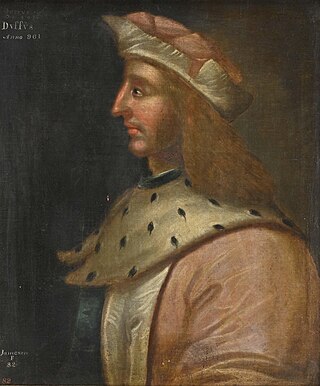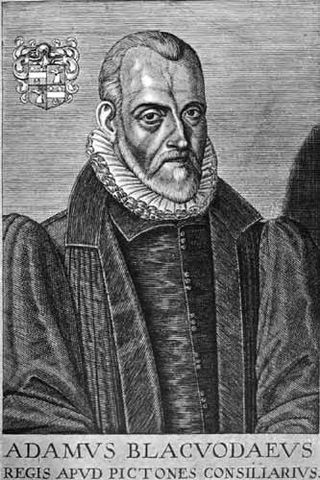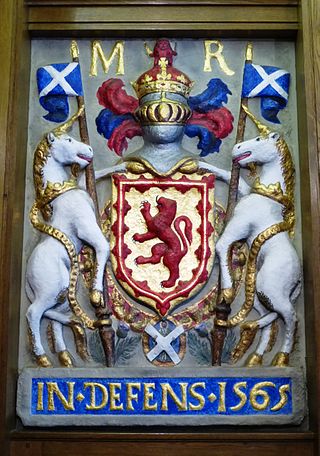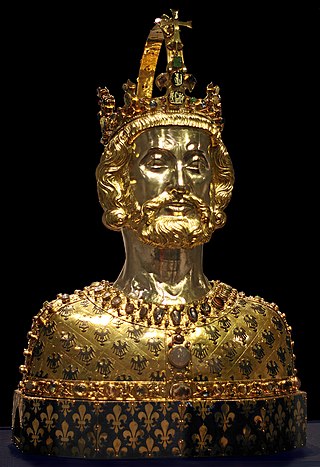
In European Christianity, the divine right of kings, divine right, or God's mandation, is a political and religious doctrine of political legitimacy of a monarchy. It is also known as the divine-right theory of kingship.

The Glorious Revolution is the sequence of events that led to the deposition of James II and VII in November 1688. He was replaced by his daughter Mary II and her Dutch husband, William III of Orange, who was also his nephew. The two ruled as joint monarchs of England, Scotland, and Ireland until Mary's death in 1694. The Revolution itself was relatively bloodless, but pro-Stuart revolts between 1689 and 1746 caused significant casualties, while the political movement known as Jacobitism persisted into the late 18th century. William's invasion was the last successful invasion of England.

Dub mac Maíl Coluim, sometimes anglicised as Duff MacMalcolm, called Dén, "the Vehement" and, "the Black" a direct translation of his name to modern English is Black Malcolmson was king of Alba. He was son of Malcolm I and succeeded to the throne when Indulf was killed in 962.

Monarchical systems of government have existed in Ireland from ancient times. In most of Ireland, this continued until 1949, when it transitioned to being the Republic of Ireland. Northern Ireland, as part of the United Kingdom, remains under a monarchical system of government.

James VI and I was King of Scotland as James VI from 24 July 1567 and King of England and Ireland as James I from the union of the Scottish and English crowns on 24 March 1603 until his death in 1625. Although he long tried to get both countries to adopt a closer political union, the kingdoms of Scotland and England remained sovereign states, with their own parliaments, judiciaries, and laws, ruled by James in personal union. He was the longest-reigning monarch of the Kingdom of Scotland.
In many historical societies, the position of kingship carries a sacral meaning; that is, it is identical with that of a high priest and judge. The concept of theocracy is related, although a sacred king does not need to necessarily rule through his religious authority; rather, the temporal position itself has a religious significance behind it.

George Buchanan was a Scottish historian and humanist scholar. According to historian Keith Brown, Buchanan was "the most profound intellectual sixteenth century Scotland produced." His ideology of resistance to royal usurpation gained widespread acceptance during the Scottish Reformation. Brown says the ease with which King James VII was deposed in 1689 shows the power of Buchananite ideas.
Germanic kingship is a thesis regarding the role of kings among the pre-Christianized Germanic tribes of the Migration period and Early Middle Ages. The thesis holds that the institution of feudal monarchy developed, through contact with the Roman Empire and the Christian Church, from an earlier custom of sacral and military kingship based on both birth status and consent from subjects.
Mirrors for princes or mirrors of princes was a literary genre of didactic political writings throughout the Middle Ages and the Renaissance. It was part of the broader speculum or mirror literature genre.

The royal touch was a form of laying on of hands, whereby French and English monarchs touched their subjects, regardless of social classes, with the intent to cure them of various diseases and conditions. The thaumaturgic touch was most commonly applied to people suffering from tuberculous cervical lymphadenitis, and exclusively to them from the 16th century onwards. The disease rarely resulted in death and often went into remission on its own, giving the impression that the monarch's touch cured it. The claimed power was most notably exercised by monarchs who sought to demonstrate the legitimacy of their reign and of their newly founded dynasties.

Adam Blackwood (1539–1613) was a Scottish author and apologist for Mary, Queen of Scots.

The monarchy of Thailand refers to the constitutional monarchy of the Kingdom of Thailand. The king of Thailand is the head of state and head of the ruling Royal House of Chakri.

The Scottish Renaissance humanist George Buchanan gave a long list of Scottish Kings in his history of Scotland—published in Latin as Rerum Scoticarum Historia in 1582—most of whom are now considered by historians to be figures of legend, or completely misrepresented. The list went back around 1900 years from his time, and began with Fergus I. James VI of Scotland, who was Buchanan's pupil, adopted the story of Fergus I as his ancestor, and the antiquity of the line was emphasised by the House of Stuart.
Resistance theory is an aspect of political thought, discussing the basis on which constituted authority may be resisted, by individuals or groups. In the European context it came to prominence as a consequence of the religious divisions in the early modern period that followed the Protestant Reformation. Resistance theories could justify disobedience on religious grounds to monarchs, and were significant in European national politics and international relations in the century leading up to the Peace of Westphalia of 1648. They can also underpin and justify the concept of revolution as now understood. The resistance theory of the early modern period can be considered to predate the formulations of natural and legal rights of citizens, and to co-exist with considerations of natural law.

The Renaissance in Scotland was a cultural, intellectual and artistic movement in Scotland, from the late fifteenth century to the beginning of the seventeenth century. It is associated with the pan-European Renaissance that is usually regarded as beginning in Italy in the late fourteenth century and reaching northern Europe as a Northern Renaissance in the fifteenth century. It involved an attempt to revive the principles of the classical era, including humanism, a spirit of scholarly enquiry, scepticism, and concepts of balance and proportion. Since the twentieth century, the uniqueness and unity of the Renaissance has been challenged by historians, but significant changes in Scotland can be seen to have taken place in education, intellectual life, literature, art, architecture, music, science and politics.

The Marian civil war in Scotland (1568–1573) was a period of conflict which followed the abdication of Mary, Queen of Scots, and her escape from Lochleven Castle in May 1568. Those who ruled in the name of her infant son James VI fought against the supporters of the Queen, who was exiled in England. Edinburgh Castle, which was garrisoned in her name, became the focus of the conflict and surrendered only after an English intervention in May 1573. The conflict in 1570 was called an "intestine war in the bowels of this commonwealth", and the period was called soon after an "intestine war driven by questions against authority."

Government in early modern Scotland included all forms of administration, from the crown, through national institutions, to systems of local government and the law, between the early sixteenth century and the mid-eighteenth century. It roughly corresponds to the early modern era in Europe, beginning with the Renaissance and Reformation and ending with the last Jacobite risings and the beginnings of the industrial revolution. Monarchs of this period were the Stuarts: James IV, James V, Mary Queen of Scots, James VI, Charles I, Charles II, James VII, William III and Mary II, Anne, and the Hanoverians: George I and George II.
Events from the year 1799 in Scotland.

King is the title given to a male monarch in a variety of contexts. A king is an absolute monarch if he holds the powers of government without control, or the entire sovereignty over a nation; he is a limited monarch if his power is restrained by fixed laws; and he is an absolute, when he holds the whole legislative, judicial, and executive power, or when the legislative or judicial powers, or both, are vested in other people by the king. Kings are hereditary sovereigns when they hold the powers of government by right of birth or inheritance, and elective when raised to the throne by choice.

The Association was the name given to plans in the 1580s for Mary, Queen of Scots, to return to Scotland and rule jointly with her son, James VI of Scotland. The plans came to nothing, despite diplomatic efforts.















